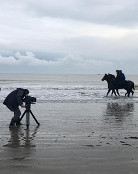Donn's Articles » Four-day Cheltenham Festival
Four-day Cheltenham Festival
In the end, common sense prevailed. It looked like the expansion of the Cheltenham Festival from four days to five was inevitable, that all it needed was a rubber stamp and a date. But on Monday, the Jockey Club announced that there would be no expansion, that that four-day Festival would remain as it is, at least for now.
The case for a five-day Cheltenham Festival was a fiscal one. An extra day would have meant an extra day’s income, up to 68,500 extra turnstile clicks and all the extra income and betting revenue that goes with an extra day at National Hunt racing’s most high-profile meeting. Roll it into Saturday, run it from Tuesday to Saturday, and you attract a different crowd, a Saturday crowd. Run the Festival into the weekend’s psyche and media.
Arguments about the dilution of quality were countered with the argument that you would have to add just two more races in order to get to five days. There are seven races on each of the four days of the Cheltenham Festival in its current guise, 28 races. Reduce the number of races per day to six, expand the number of days to five, and that’s 30 races, just two more than now. There was lots of talk even about what the extra races would be: a two-and-a-half-mile hurdle, a veteran’s chase, a mares’ novices’ chase. There were options, niches in the Cheltenham Festival programme that could have been filled. Extra opportunities for the best horses to avoid each other.
We had been there before too.
Three days used to be enough. Six races each day, Tuesday to Thursday. In 1992, they added the Champion Bumper and in 1993 they added the Coral Cup, still three days though, six races on Tuesday, seven on Wednesday and on Thursday. Then there was the root and branch change in 2005, the move to four days, the addition of five new races and the removal of one. That made it a 24-race Festival, the reduction of the number of races each day to six, but the move to four days, Tuesday to Friday.
It didn’t take long for the creep to start though. In 2008, just three years after the move to four days, the Mares’ Hurdle was added. The following year the Martin Pipe Conditional Jockeys’ Hurdle was added. Then the Jewson Chase in 2011 and the Mares’ Novices’ Hurdle in 2016, so that we were up to 28 races, eight more than there were in 2004, just 12 Festivals earlier.
You could argue that the new races were in different disciplines, that they catered for different types of horses, but that’s like adding an 1100-metre race to the Olympics programme and claiming that it wouldn’t impact on the 800 metres or the 1500 metres. There is, by definition, in all walks of life, only a finite number of top-class performers.
You have to commend the Jockey Club for at least not adding further water to an already diluted solution. A number of reasons were cited for the decision to retain the status quo, including the lack of certainty over terrestrial television coverage on ITV’s main channel and the impact that five days’ racing would have on the ground. Whatever the reason, the decision is a good one for National Hunt racing.
The Cheltenham Festival has evolved into the hugely important entity that it now is over time, and it has been able to grow in stature and in profile because it has its roots so deeply embedded in history. It is the pinnacle of National Hunt racing, the season’s crescendo.
And it is more about prestige than it is about prize money. For example, the County Hurdle, a Grade 3 Class 1 two-mile handicap hurdle, run at Cheltenham in March, was worth £56,270 to the winner in 2022. The Betfair Hurdle, another Grade 3 Class 1 two-mile handicap hurdle, run at Newbury a month earlier, was worth £87,218 to the winner in 2022, 55% more than the County Hurdle. But the County Hurdle is run at the Cheltenham Festival. There were 26 runners in the County Hurdle this year; there were just 14 runners in the Betfair Hurdle.
Field sizes are an issue in Britain, there is a dearth of runners for the number of races that there are. The top National Hunt horses can dance around each other for most of the season if they wish to, and they do. Given that that is the case, it is important that they meet at Cheltenham.
More days at Cheltenham, more races, would have meant more opportunities for the top horses to avoid each other even at Cheltenham while still competing for top honours, and that is obviously not in the long-term interest of the sport. If there is to be another move for a change in the number of races at the Cheltenham Festival in the near future, it should be a move to reduce that number, not increase it.
There is an extraordinariness to the Cheltenham Festival that is difficult to define or create. There is something special about a Cheltenham Festival winner. An rud is annamh is iontach. But the more you dilute it, the more you stretch it, the greater risk you run that you will extinguish the extraordinary, and you will not know that you have done so until it is too late. You don’t know that you have put too much air into the balloon until it bursts.
© The Sunday Times, 22nd October 2022


 Follow Donn
Follow Donn